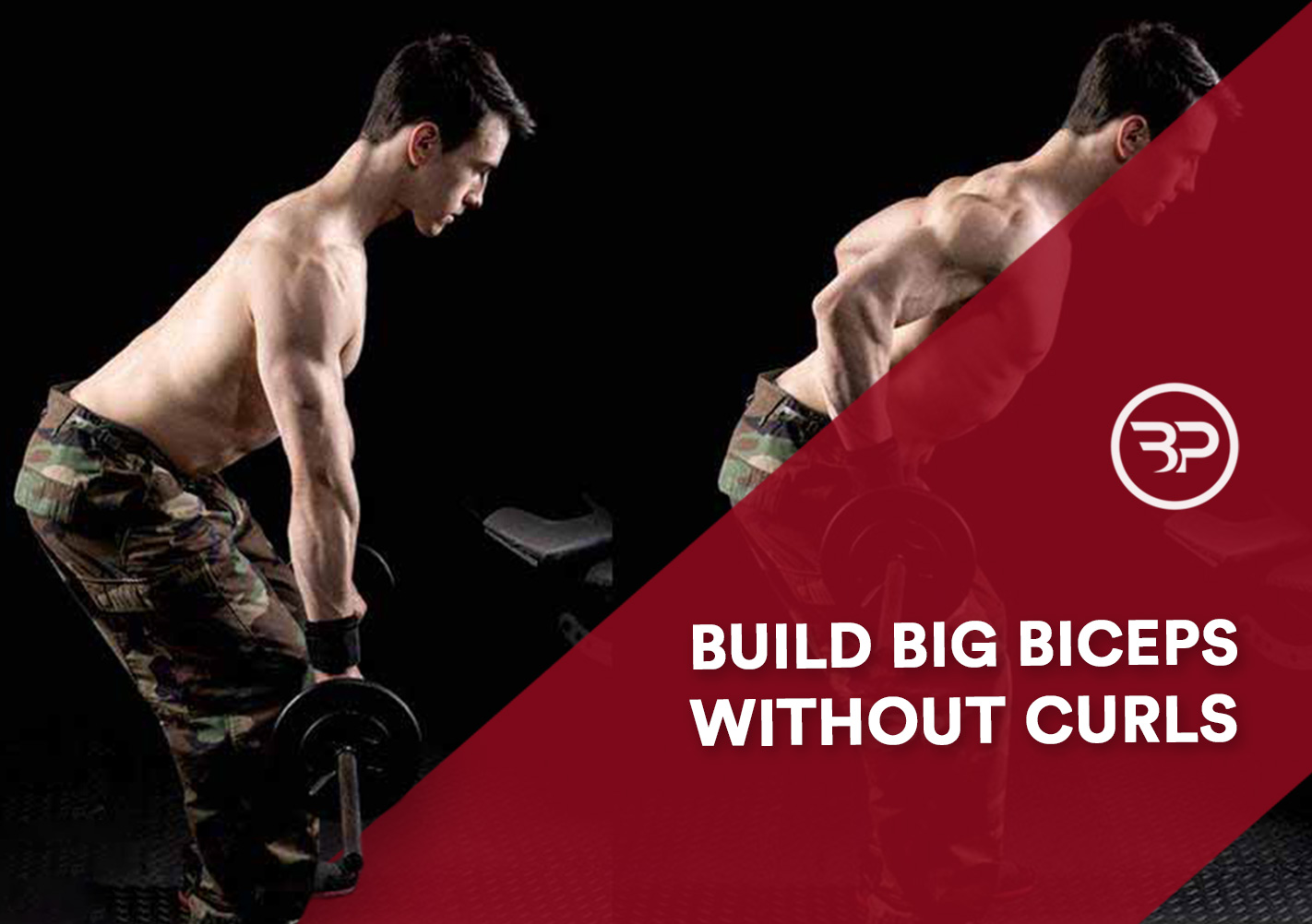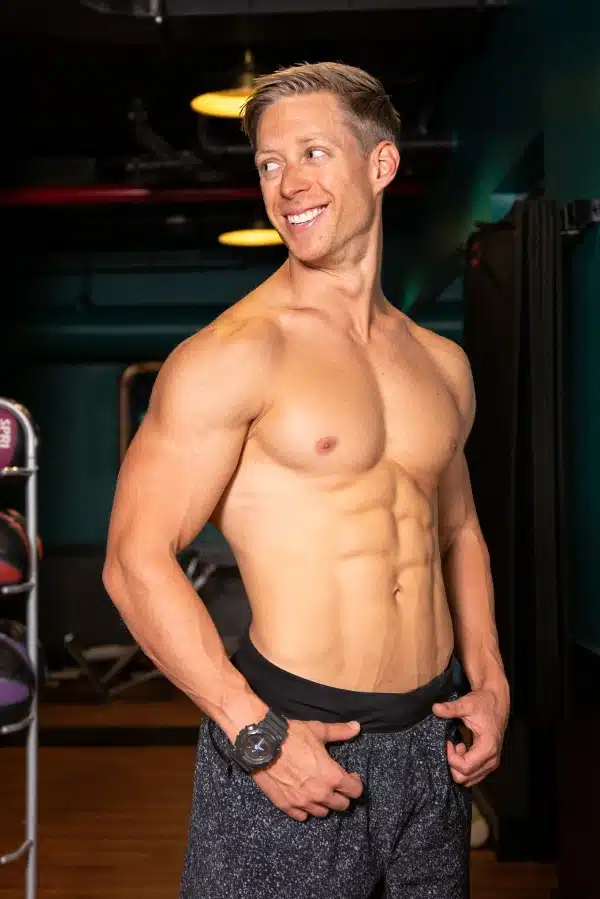Build Big Biceps Without Curls
September 27, 2016
Ever since I was a kid, I’d wanted big biceps.
From Arnold bustin’ out of his camo in Predator and Scott Steiner kissing his biceps on WCW, big arms said it all. They were a staple of having a strong, bad ass body.
Guns. Pythons. Pipes. Whatever you wanted to call them, I wanted them.
Fifteen years later, the fact remains: Dudes want big biceps.
Problem is, most guys head straight for the dumbbell rack or preacher curl to get them, yet fail to fill out a smedium shirt.
Trust me, I did make this mistake for years. I felt tricked by most bodybuilding magazines that had me doing five variations of curls three days per week.
As if curling 15 pound dumbbells for three sets was the Magic Unicorn that would take me to the land of swole biceps.
Tsk, tsk.
Boy, was I wrong.
Instead of a thick set of biceps hangin’ on my shoulders, I was stuck with pipe cleaners that were invisible when I turned sideways.
Finally, with the help of coaches and experience under the bar, I neared the truth.
Unless you’re a genetic freak, you’ll never build swole bi’s without first getting bigger and stronger globally.
Before going any further, grab a copy of your chiseled muscle cheatsheet. This step-by-step guide gives you everything you need to know to add 10-15 pounds of pure muscle.
Endless sets of curls are the last way you’ll ever get big biceps unless you have the foundation to support them.
With that in mind, I’m hooking you up with the best bang-for-your-buck biceps builders. Once you’re strong in these lifts, your body will be ready to add the finishing touches with curls. And you’ll be stretching shirt sleeves and handing out Predator handshakes in no-time.
Why you Need to Be Strong to Build Muscle
A baseline of strength is imperative to building muscle. In gym newbies, adding more weight to the bar builds muscle because you’re increasing total body stress, increasing muscle fiber recruitment and boosting anabolic hormone levels.
As you get more advanced, training purely for strength builds less and less muscle. But, lifting heavy is still important for two reasons.
First, lifting progressively heavier weights activates a greater number of muscle fibers during training. Since you can’t build muscles that aren’t firing, better muscle fiber recruitment leads to more growth.
Second, with a greater level of strength you’ll be able to create more training stress. That means more muscular damage, increase metabolic stress (that wicked pump, bro), and mechanical tension—the three primary methods of muscle growth.
Like Ronnie Coleman said, “ Everyone wants to be a bodybuilder, but nobody wants to lift heavy ass weight!”
That means getting strong first to earn the right to benefit from higher rep curl work later on.
Make sense?
Good.
Biceps Builders
1. Supinated Grip Bent Over Row
Using an underhand grip on your rows puts a ton of tension and direct loading on the biceps.
Since most bro’s ONLY blitz their biceps with lighter, higher rep sets, they’re not placing their biceps under enough tension to stimulate new growth. That’s where supinated grip bent over rows fill the gap, stimulating untapped muscle fibers to grow bigger biceps.
Metabolic stress and long-duration sets are important for hypertrophy. But, strength comes first and you need to stimulate fast-twitch muscle fibers with heavy loads, like underhand grip rows. Keep reps moderate-heavy, aiming for a high volume in the 6-8 rep range.
Rep schemes like 4-5×6-8 will do the trick.
As the saying goes, “ Wanna grow? Gotta Row!”
2. Neutral Grip Chin-Up:
The neutral grip chin-up isn’t actually a biceps builder, but it may as well be. The neutral or hammer grip builds your brachialis, a muscle underneath the biceps.
For a lot of guys, the brachialis in underdeveloped, which limits both the growth and appearance of your arms. By hammering the neutral grip position you’ll get bigger arms for two reasons.
1. Your body likes to grow in proportion. By hitting under-stimulated muscle groups, you’re pushing your body to adapt to new stressors, promoting muscle growth. This is why reason specialization workouts work so well.
2. The brachialis is under your biceps. Building a bigger brachialis pushes the biceps up, giving your biceps a bigger peak and increasing the circumference of your arm.
3. Squats
Wait..what?
No, this isn’t a typo.
80% of lifters chasing bigger arms need to get bigger and stronger.
You’ll never have a thick back, big chest, or big arms without being a strong MoFo.
And while this isn’t new to you, most people ignore this blatantly simple rule.
Get strong is basic lifts like the squat to build muscle instead of diving head first into a biceps specialization program before you’re ready.
I’m not saying that squats alone build a big biceps, but the tension created in big exercises develops your entire body, setting the table for specific isolation work going forward.
Once you master the power movements and are able to handle impressive poundages on those lifts, the strength and muscle you gain will translate into greater weights used in arm, shoulder and chest exercises.
The greater your strength development in the biggest muscles of your body, the greater the strength and size potential in the smaller muscles.
Since the squat is the unofficial king of all exercises, increasing your strength here will stimulate total body muscle growth. And that means bigger biceps.
4. Rope Climb
When I hear the rope climb, I flash-back to Elementary school gym class. Hand over hand like a Spider monkey, I’d fly up the rope. All for bragging rights with my fellow eight year old cronies… Little did I know, that rope climb could get me jacked.
Unfortunately, climbing rope is a lost art. It’s too “dangerous” for gym class, and often dismissed as a strength building exercise. It’s a crying shame.
Still, if you can find a climbing rope, you have the most underrated tool to build incredible grip strength and forearms as well as powerful lats, big biceps, and strong abs.
If you have ropes at your gym, begin with your butt on the ground, and use a hand-over-hand climb to pull yourself to standing without using your legs. Then, lower yourself to the ground.
https://www.youtube.com/watch?v=926H-gvXQuU
Too tough?
Try it with your legs bent.
Rope climbs are tough and demanding both on the tissues of arms and your neuromuscular system. Keep them to once or twice per week for 2-3 sets of 3-5 climbs.
If you want to build a set of arms that are as strong as they look, then rope climbing could be the missing link.
5. 2 for 1 Inverted Rows
The inverted row is an excellent horizontal pulling exercise that blasts your biceps, forearms, and lats. Further, it’s the perfect regression if you can’t bang out chin-ups.
Taken a step further, the typical inverted row becomes an incredible muscle builder when using accentuated eccentrics and the two for one method.
As a brief overview, the eccentric of your lift is the negative, or lengthening part of an exercise. You’re stronger in the eccentric action, meaning a higher external load can be used with eccentrics (Colliander et al. 1990). This means greater strength gains.
Further, more microtrauma and muscular damage occur with a focus on eccentric muscular actions (Gibala et al. 2000). Greater muscular damage is one of the key components in muscle growth (Schoenfeld, 2010).
As you can see, focusing on eccentrics in you training helps you build strength and size.
When applied to the row, my favorite accentuated eccentric technique is the 2 for 1 inverted row.
It’s pretty simple: on the way up (concentric phase), you’ll use two arms.
Inverted Row: Pull yourself to the bar with two arms.
On the way down (eccentric), you’ll remove one arm, lowering yourself with only one arm.
This significantly overloads the eccentric portion, causing a ton of muscular damage and pushing your strength and size gains to the max. Perform the concentric (up) as fast as possible, then take 3-5 seconds on the way down.
Three to four sets of five to six reps per limb will stimulate massive growth.
Building Big Biceps
Growing bigger arms is a process that must be preceded by a focus on total body strength and development. Without first building this foundation, you’ll never have the base to specialize and get great results.
Adding in Isolation Work
I’m not one of those coaches that thinks you’ll maximize arm development by getting strong and doing tons of chin-ups.
Far from it.
Isolation work is important, but it’s something you need to work towards. Get strong in your big lifts and start using supinated and neutral grips. Then, once you’re moving big weight for six to eight reps, add in curls at the end of your training twice per week. Focus on the pump and feel the muscle doing the work, getting stronger in the ten to fifteen rep range.
Follow my lead, and you’ll finally build big biceps.
Grab a copy of your chiseled muscle cheatsheet. This step-by-step guide gives you everything you need to know to add 10-15 pounds of pure muscle.
References
1) Baechle, Thomas, and Roger Earle. Essentials of Strength and Conditioning. 3rd. Champaign, Il: Human Kinetics , 2008. 406-407. Print.
2) Colliander EB., Tesch PA., Effects of eccentric and concentric muscle actions in resistance training. Acta Physiol. Scand. 140:31-39, 1990
3) Gibala MJ., Interisano SA., Tarnopolsky MA., Roy BD., MacDonald JR., Yarasheski KE., MacDougall JD. Myofibrillar disruption following acute concentric and eccentric resistance exercise in strength-trained men. Can J Physiol Pharmacol 78(8):656-661. 2000









